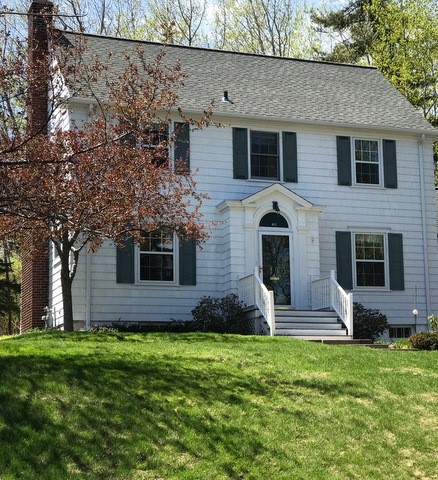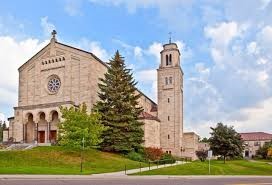North Country Girl: Chapter 4 — 411 Lakeview Avenue
For more about Gay Haubner’s life in the North Country, read the other chapters in her serialized memoir. The Post will publish a new segment each week.
When I was 6, we moved out of the Woodland ranch into a fancier neighborhood, one with bigger, older houses and lots of trees. Our new home at 411 Lakeview Drive was a white, two-story house that looked like a child’s drawing: doors, windows, slanted green roof. Before moving in my mother remodeled the bathroom, tearing down the 50’s black and white wallpaper with cartoon-like drawings of people showering and shaving that I loved, as well as the kitchen, putting in a new-fangled garbage disposal, which terrified me — what if my hand got stuck! — and a very 60’s dropped ceiling of Styrofoam-like tiles. The week we moved in, I smuggled a bottle of Coca-Cola into the house, and put it in the freezer to get cold. When I popped it open an hour later the pop shot up all the way to the ceiling, splashing the brand new white tiles with never-to-be-removed Coke stains and sending my mother round the bend.

On one side of our Lakeview house were the McCauleys; they had built a little playhouse in their back yard for their granddaughters, who I never saw once. For some reason, the playhouse was locked, but I could gaze longingly through the windows at the tiny stove, sink, table and chairs. What wonderful grandparents to build a playhouse! I thought, resentful that my grandfather had only built a bomb shelter big enough to hold the entire population of Carlton.
On the other side of our house was a wooded lot, with a little creek that appeared magically in the spring, after the snow melted, just big enough to sail leaf boats down and get soaking wet up to the knees. In the summer there were interesting-looking mushrooms and tiny wild strawberries to collect. There were places in the lot where the trees were thick enough for me to pretend I was in a real forest, and that I was Red Riding Hood or Gretel.
The best part was the back yard, which ended in a five-foot scramble up an outcropping of granite. This was an excellent place to play pirates or princesses, with the huge Holy Rosary Cathedral looming behind standing in for a fortress or castle. On this rocky knoll grew blueberry bushes with tiny tart berries, and bushes with shiny red berries that looked tempting but were mouth-puckering inedible. The neighborhood kids called these “poison berries” and dared each other to eat them. There was one tree with low-slung branches that was excellent for climbing, that I once fell out of, landing flat on my back. I got the wind knocked out of me and then was frightened to death by Nancy Green, who watched me gasping for breath and cheerfully informed me that I had lockjaw and had to go get a shot.

I didn’t get my longed for playhouse, but my father put up a metal swing set that he didn’t bother to set deeply enough in the ground so it threatened to topple over every time we swung too high. If Lani and I got our swings in tandem we could watch the poles, front back, front back, being pulled all the way out of the grass. One winter my dad flooded the back yard to create our own ice rink, where I skated once or twice, before heading over to the big neighborhood rink, which had a warming shed with hot chocolate and Milk Duds and Sugar Babies, and kids to play Snap the Whip with, until the rink guy emerged from the shed to stop us from cracking our heads open. The final transformation of the back yard was into a kennel for two hunting dogs that slunk miserably back and forth for months before disappearing.
***
Grownups in Duluth had children and then immediately forgot about them, until they were required to all be some place, like dinner, or Sunday mass, or high school graduation. We were turned out of doors at an early age and expected to amuse ourselves. I stood in the street outside of our new house for about two minutes before being approached by a gang of grubby kids of assorted sizes asking if I wanted to play. They must have sniffed me out by my kid smell, a mélange of Cheerios, Crayolas, and new doll.
Nancy Green was the first friend I made when we moved into 411 Lakeview. She was a few years older than me, and all her clothes came from the unfortunately named Chubbettes department at The Glass Block, and she was an excellent organizer of spud, freeze tag, and all those other forgotten outside games. Immediately upon meeting me, Nancy eagerly broke the news that Santa wasn’t real and the Christmas presents under the tree came from my parents. I went weeping home to my mother who denied this calumny so vehemently and directed such hatred toward Nancy for telling me such a thing, that I ended up believing in Santa for several more years than I should have.
My mother decided a better friend for me was the older woman who lived across the street, an amateur naturalist. Her home did not have the usual manicured lawn. Her shadowy front yard was studded with massive pines, a scary miniature Black Forest I had to venture across to ring her bell. She was a stocky woman, with short dark hair and Germanic-looking walking shorts, who knew every tree and wildflower of northern Minnesota and insisted on pointing out all of them to me. After a day spent trailing her around, I would return home late in the afternoon, exhausted and dusty and dying of thirst, having trekking miles through the woods and along ice-cold brooks plashing down to Lake Superior. I don’t know if I was relieved or unhappy when the Amateur Naturalist moved away.
I much preferred exploring on my own. I would walk to the end of Lakeview Drive, cross Hawthorne Road, and trespass through an immense acreage of someone’s yard to reach Congdon Creek. Faint trails led up and down the banks of the creek; where they disappeared, I would hopscotch across the brook, usually falling in at least once. If I broke through the ice during a winter walk, I would have to head home immediately, before my two pairs of socks froze up inside my rubber boots and my feet turned blue. In the few months of balmy weather I could venture upstream as far as I liked, turning over rocks, collecting bits of birch bark and wildflowers, and watching water striders scoot across still pools.
Vermillion Road ran parallel to our street, I could get there by walking through the wooded lot beside our house and then the Hyleck’s side yard. Crime was so rare in Duluth that we never locked our house, but Mrs. Hyleck, who was a noted scold, was found clubbed to death in her basement one winter night, and her husband arrested for her murder. My mother attended every day of his trial, as it offered even more drama than her beloved As the World Turns soap opera. Mr. Hyleck was convicted of murdering his wife but always maintained he was innocent; he died in prison and in his will he asked that his ashes be scattered from a plane over the city that had so wronged him.
When I took the short cut across the wooded lot and the Hyleck’s yard, I was headed to the to the homes of two girls my age, Patty and Debbie, who lived next to each other and were best friends, and who graciously allowed me to play with them. Patty was thin and cute, Debbie was pie-faced and voracious; when I asked her what she wanted for her birthday, she said a jar of mayonnaise and a spoon, the idea of which sent me outside to throw up, which I did standing in one place. In September, I stopped playing with Debbie and Patty; good Catholic girls, they went to Holy Rosary’s parochial school. I started second grade in my new school, Congdon Park Elementary.